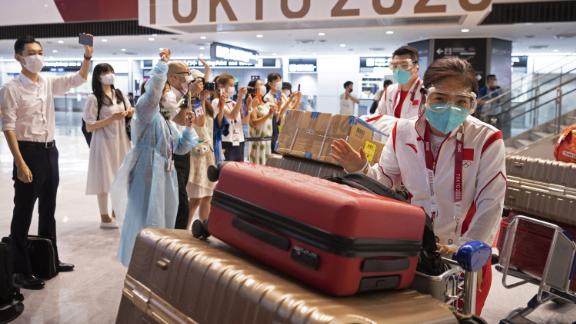Editor’s Note: A version of this story appeared in CNN’s Meanwhile in China newsletter, a three-times-a-week update exploring what you need to know about the country’s rise and how it impacts the world. Sign up here.
Hong Kong
CNN
—
The death of nine Chinese workers in a bus explosion in Pakistan has underscored the security risks attached to China’s overseas projects, as anti-China sentiment simmers in countries where official ties with Beijing are strong.
The bus was carrying a convoy of Chinese engineers to the construction site of the Dasu hydropower plant in northern Pakistan when the blast occurred, killing 13 people.
Initially, Pakistan and China had released conflicting statements over the cause of the incident. Islamabad blamed a gas leak caused by mechanical failure, while the Chinese Foreign Ministry called it a “bomb attack,” expressing “shock and condemnation” and asking Pakistan to “severely punish” the perpetrators. The discrepancy raised confusion – and anger – on Chinese social media, with some accusing Pakistan of “covering up” the truth.
Then, in an apparent twist on Thursday, Pakistan’s Information Minister Fawad Chaudhry said on Twitter that “terrorism cannot be ruled out,” after initial investigations confirmed “traces of explosives.” By Friday, Chinese Premier Li Keqiang was describing the blast as a “terrorist attack” in his phone call with Pakistani Prime Minister Imran Khan – which Chinese state media took as a confirmation from both sides on the nature of the incident.
China has sent a team of criminal investigation experts to Pakistan to join the probe, according to Chinese Minister of Public Security Zhao Kezhi. But will that be enough?
As Beijing’s economic footprint grows, so too do the security risks. According to data published by the RAND Corporation, a US-based nonprofit think tank, more than 30,000 Chinese enterprises are located overseas, and more than 100 million Chinese citizens travel abroad annually.
Will Beijing one day be forced to deploy its own defense assets overseas to protect those citizens and enterprises?
The bus explosion is among the deadliest attacks on overseas Chinese nationals in recent years. Faced with rising nationalism at home, and increasing geopolitical tensions abroad, Beijing will need to show that it is serious about protecting Chinese citizens without damaging relations with Pakistan, one of its few close allies.
Speaking to his Pakistani counterpart, Li urged Islamabad to “use all necessary means” to investigate the attack and hold the culprits accountable, and “do its utmost to prevent similar incidents from happening again.” He also underscored the “all-weather” strategic partnership between the two countries, and vowed to strengthen cooperation.
But the incident has highlighted the vulnerability of Chinese projects in Central Asia, the number of which has boomed in recent years under Beijing’s ambitious Belt and Road trade and infrastructure scheme.
Under specific threat is the China-Pakistan Economic Corridor (CPEC), a $60 billion Belt and Road flagship project that links China’s western Xinjiang region to Pakistan’s strategic Gwadar port on the Arabian Sea with a network of roads, railways, pipelines and power plants.
Although the Dasu hydropower plant is not included in the list of energy projects on CPEC’s official website, the incident is likely to send a chill through the large numbers of Chinese nationals working on CPEC projects.
Chinese-funded projects have sparked resentment from locals in parts of Pakistan, who say they have benefited little from the developments. The anti-China sentiment is particularly strong among separatist groups in Balochistan, a western province where the Gwadar port is located.
In November 2018, the Balochistan Liberation Army (BLA) claimed responsibility for an attack on the Chinese consulate in the city of Karachi, which killed four people. Half a year later, a separatist group attacked a luxury hotel in Gwadar, commonly used by Chinese nationals working at the port. In June 2020, the BLA said it was responsible for another deadly attack on the Pakistan Stock Exchange, where Chinese companies own 40% of the stakes.
While nobody has claimed responsibility for the bus explosion, Chinese experts have pointed to Balochistan militants and the Pakistani Taliban as possible perpetrators.
The security situation could worsen in the coming months as Pakistan braces itself for a spillover of violence from neighboring Afghanistan, where the Taliban is taking control of great swathes of the country following the withdrawal of American troops.
As of now, Beijing has been mainly relying on Pakistani security forces – consisted of thousands of soldiers and police officers – for the protection of Chinese nationals and projects. But increasingly, Chinese businesses with risky investments could be turning to China-based private security companies for protection, too.
According to a report released last month by the Washington-based Center for Advanced Defense Studies, China-based companies account for 29 of the 49 foreign private security firms operating in Cambodia and Myanmar. The report shows these companies were incorporated steadily since 2013, with spikes in 2019 and 2020 – timing that likely tied to the rise of Belt and Road projects.
- Indonesia is battling a devastating Covid-19 crisis, with thousands of cases and hundreds deaths reported every day and hospitals running dangerously low on supplies. But experts warn its peak is likely still to come.
- China and Australia have found another battleground for their deepening diplomatic standoff: the Pacific Islands’ pandemic response. Canberra has hit back at Beijing’s claims it is derailing the rollout of Chinese vaccines in Papua New Guinea (PNG), the most-populous Pacific nation.
- The Biden administration sanctioned seven Chinese officials Friday amid continued crackdowns in Hong Kong by the Chinese government. It also warned US businesses in an advisory issued Friday of the “growing risks” posed by the governments in Beijing and Hong Kong.
- Cannabis’ earliest roots may have stemmed from northwestern China – not South Asia as commonly believed, according to a study published on Friday.

Charly Triballeau/AFP/Getty Images
Ping pong diplomacy: Chinese table tennis player Liu Shiwen arrives at Japan’s Narita International Airport over the weekend. China is sending 431 athletes to the Tokyo Games as part of a 777-member delegation, its largest dispatch to an Olympics outside China.
The world’s biggest emitter of greenhouse gas pollution launched the world’s largest carbon trading market last week.
This long-awaited program is a key step in China’s efforts to reduce its carbon emissions. The market works this way: the government gives every company the right to emit a certain amount of carbon dioxide each year. If you emit less than that, you can sell excess allowances, or “the right to pollute,” on the market. If you need more than that, you can buy extra from the market.
On the first day of trading on Friday, 4.1 million metric tons of carbon dioxide quotas traded on the Shanghai Environment Energy Exchange, worth $32 million. Compared to China’s overall emissions, the trading volume was small, but it’s “an encouraging step forward,” said Betty Wang, senior China economist for ANZ Research, in a research report on Monday.
The market is currently the world’s largest emissions trading scheme by volume, according to analysts from Eurasia Group. At the initial stage, it covers more than 2,000 power plants with 4.5 billion metric tons of emissions per year, or about 40% of China’s annual emissions.
According to China’s 14th Five Year Plan — a policy blueprint for the 2021-2025 period— the system’s coverage will be extended to seven other sectors by the end of 2025, including petrochemical, chemical, construction, and steel. By then, it may cover 8 billion metric tons of emissions per year.
But given that the market covers only the power sector for the moment, “it remains to be seen whether such initial enthusiasm will persist and how long it will take before the trading volume and market liquidity reach the level at which the ETS can be an effective instrument for achieving China’s climate ambitions,” analysts from Eurasia Group said in a report over the weekend.
“More work must be done,” they said, such as releasing new regulations to govern the scheme and verifying the emissions data submitted by firms.
China is currently the world’s largest carbon emitter. In the year ending March 2021, it emitted nearly 12 billion metric tons of carbon dioxide, according to an estimate by Carbon Brief. Chinese President Xi Jinping has pledged China would achieve carbon neutrality by 2060, and to peak carbon emissions by 2030.
– By Laura He
You may also like
-
Afghanistan: Civilian casualties hit record high amid US withdrawal, UN says
-
How Taiwan is trying to defend against a cyber ‘World War III’
-
Pandemic travel news this week: Quarantine escapes and airplane disguises
-
Why would anyone trust Brexit Britain again?
-
Black fungus: A second crisis is killing survivors of India’s worst Covid wave

